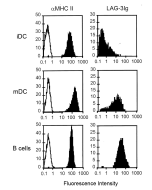Cookie Policy: This site uses cookies to improve your experience. You can find out more about our use of cookies in our Privacy Policy. By continuing to browse this site you agree to our use of cookies.
AdipoGen Life Sciences
FGL1 (human) (rec.) (His)

| Product Details | |
|---|---|
| Synonyms | Fibrinogen-like Protein 1; FGL-1; Hepatocyte-derived Fibrinogen-related Protein 1; HFREP-1; Hepassocin |
| Product Type | Protein |
| Properties | |
| Source/Host | HEK 293 cells |
| Sequence |
Human FGL1 (aa 23-312) is fused at the C-terminus to a His-Tag. |
| Crossreactivity | Human |
| Application |
Binds to LAG-3 (human):Fc (human) (AG-40B-0031) by ELISA. Can be used to detect human LAG-3 at the surface of cells. |
| Biological Activity |
Should activate human LAG-3 (activity test not yet performed). |
| MW | ~35kDa (SDS-PAGE) |
| Purity | ≥95% (SDS-PAGE) |
| Endotoxin Content | <0.01EU/μg purified protein (LAL test). |
| Concentration | After reconstitution: 0.1mg/ml |
| Reconstitution | Reconstitute with 100μl sterile water. |
| Accession Number | Q08830 |
| Formulation | Lyophilized. Contains PBS. |
| Other Product Data |
UniProt link Q08830: FGL1 (human) |
| Shipping and Handling | |
| Shipping | BLUE ICE |
| Short Term Storage | +4°C |
| Long Term Storage | -20°C |
| Handling Advice |
After reconstitution, prepare aliquots and store at -20°C. Avoid freeze/thaw cycles. Centrifuge lyophilized vial before opening and reconstitution. PBS containing at least 0.1% BSA should be used for further dilutions. |
| Use/Stability | Stable for at least 6 months after receipt when stored at -20°C. |
| Documents | |
| MSDS |
 Download PDF Download PDF |
| Product Specification Sheet | |
| Datasheet |
 Download PDF Download PDF |
FGL1 (Fibrinogen-like protein 1, also called Hepatocyte-derived fibrinogen-related protein 1, HFREP-1 or Hepassocin) was initially identified as an overexpressed transcript in hepatocyte carcinoma and as a transcript enriched in regenerating liver. FGL1 is expressed at lower levels in brown and white adipose in the setting of liver injury. A low level expression of FGL1 is also observed in the pancreas. FGL1 is a 34kDa protein structurally similar to Angiopoietin-like factors 2, 3, 4 and 6, which regulate lipid metabolism and energy utilization. It was proposed that FGL1 is a member of an emerging group of proteins having potential roles in liver metabolism and liver regeneration. Recently, FGL1 has also been shown to be upregulated in human cancers and FGL1 is a major functional ligand of LAG-3. FGL1 interacts with LAG-3 in a MHC-II-independent manner and this interaction involves the FGL1 fibrinogen-like domain and the LAG-3 D1-D2 domain. FGL1-LAG-3 interaction blockade promotes tumor immunity by stimulating T cell expansion and activation. FGL1 forms two disulfide-linked homodimers and also higher molecular weight homooligomers that bind to LAG-3 much better than the dimeric forms. This binding to LAG-3 inhibits T cell responses. The recombinant fusion protein Fc (human):FGL1 (human) (FGL1-Ig) has been shown to function as an efficient ligand of LAG-3.
- Fibrinogen-like Protein 1 Is a Major Immune Inhibitory Ligand of LAG-3: J. Wang, et al.; Cell 176, 334 (2019)








